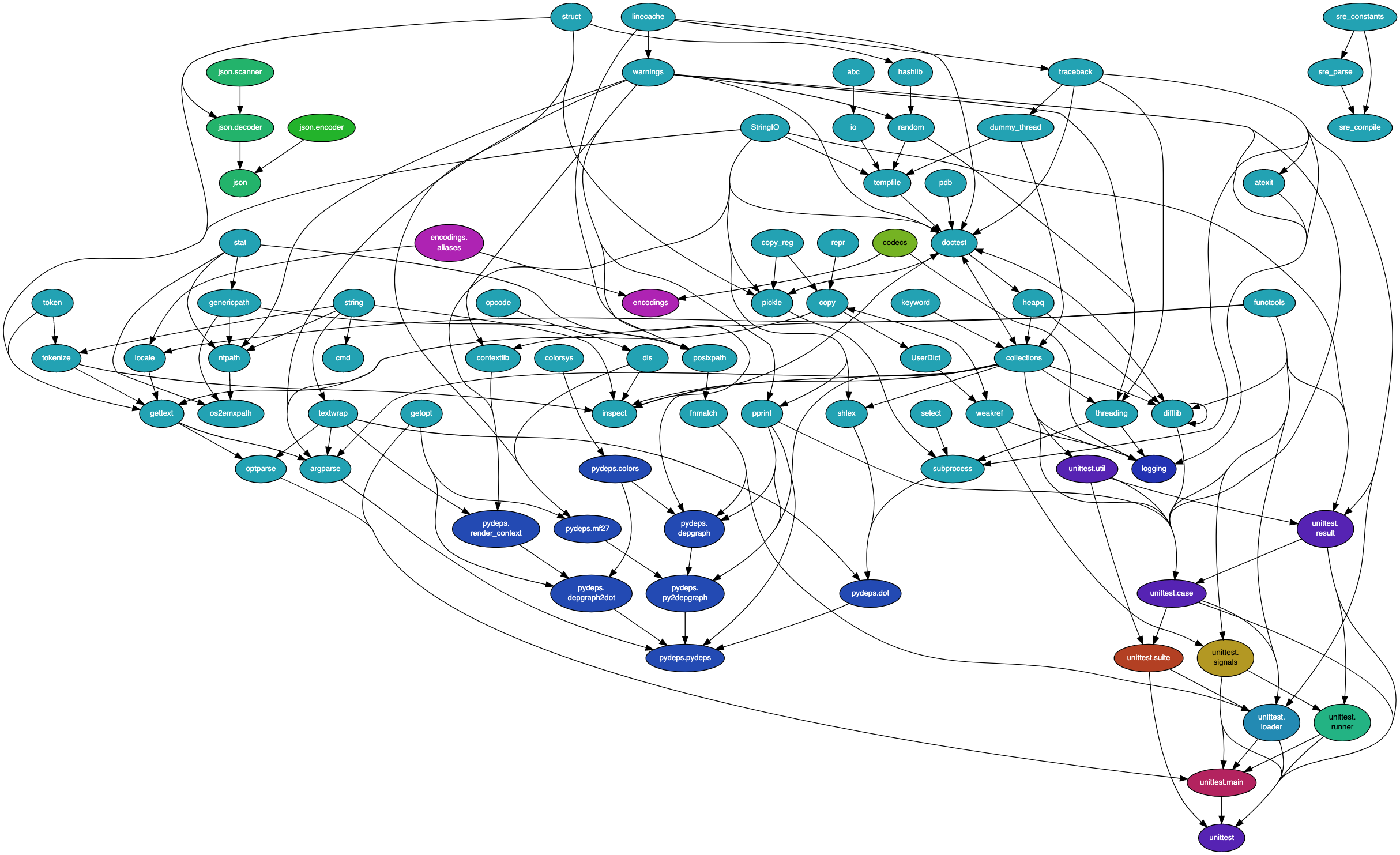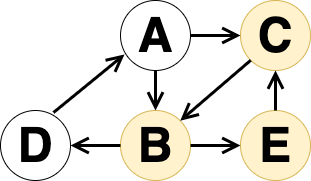 I woke up in the late afternoon and decided - it's all time, it's time to make a new feature in my library . And for one and check the graph for cycles to fix and speed up. By morning lunch I made a new feature, improved the code, made the graph representation in a convenient form, and got to the problem of finding all simple cycles in the graph. Sipping a cup of cold water, I opened Google, typed "search for all simple cycles in a graph" and saw ...
I woke up in the late afternoon and decided - it's all time, it's time to make a new feature in my library . And for one and check the graph for cycles to fix and speed up. By morning lunch I made a new feature, improved the code, made the graph representation in a convenient form, and got to the problem of finding all simple cycles in the graph. Sipping a cup of cold water, I opened Google, typed "search for all simple cycles in a graph" and saw ...
I didn't see much ... although it was only 4 o'clock in the morning. A couple of links to algorithms link1 , link2 , and a lot of hints thatit's time to sleepThere can be many cycles in the graph, and in the general case the problem is not solvable. And another question on Habré on this topic, the answer to which did not save me either - I already knew about the search in depth.
But once I have solved, then even NP will solve a difficult problem in P , the more I drink water, not coffee - and it cannot end abruptly. And I knew that within the framework of my task, it should be possible to find all the cycles in a short time, without supercomputers - not the order of magnitude for me.
Let's digress a little from the detective, and understand why I need it.
What is this library?
The library called DITranquility is written in Swift and its task is to inject dependencies . The library copes with the task of dependency injection with a bang, has capabilities that other Swift libraries cannot, and does it with good speed.
But why should I get into the habit of checking for loops in the dependency graph?
For the sake of killerfichi - if the library does the main functionality with a bang, then you are looking for ways to improve it and make it better. A killefic is checking the dependency graph for correctness - it is a set of different checks that allow you to avoid problems during execution, which saves development time. And checking for cycles stands out separately among all checks, since this operation takes much longer. And until recently, uncivilized more time.
, , , . , "Graph API" . "Graph API" — , :
- - . , , , .
- , - — graphvis.
- .
— , ...

, :
- MacBook pro 2019, 2,6 GHz 6-Core i7, 32 Gb, Xcode 11.4, Swift 5.2
- Swift 300+ ( )
- 900
- 2000
- 40
- 7000
debug , release, debug.
, 95 .
3 , .
1.
. , .
, . Graph API , , . . , , , .
, , — . , , , :
, , , . , — , . — ?
, - :
Graph:
vertices: [Vertex]
adjacencyList: [[Edge]]
Vertex:
more information about vertex
Edge:
toIndices: [Int]
information about edge Vertex , Edge , , .
, . , , , , .
2.
func findAllCycles() -> [Cycle] {
result: [Cycle] = []
for index in vertices {
result += findCycles(from: index)
}
return result
}
func findCycles(from index: Int) -> [Cycle] {
result: [Cycle] = []
dfs(startIndex: index, currentIndex: index, visitedIndices: [], result: &result)
return result
}
func dfs(startIndex: Int,
currentIndex: Int,
// visitedIndices
visitedIndices: Set<Int>,
// result -
result: ref [Cycle]) {
if currentIndex == startIndex && !visitedIndices.isEmpty {
result.append(cycle)
return
}
if visitedIndices.contains(currentIndex) {
return
}
visitedIndices += [currentIndex]
for toIndex in adjacencyList[currentIndex] {
dfs(startIndex: startIndex, currentIndex: toIndex, visitedIndices: visitedIndices, result: &result)
}
}, 10 … , , — - ...
, — ? , ? , dfs , 30 . 900 * 1000000 = 900.000.000 dfs…
3.
, , , , , - … , , , !
, , , , . — , , . , , , - :
func findAllCycles() -> [Cycle] {
globalVisitedIndices: Set<Int> = []
result: [Cycle] = []
for index in vertices {
if globalVisitedIndices.containts(index) {
continue
}
result += findCycles(from: index, globalVisitedIndices: &globalVisitedIndices)
}
return result
}
func findCycles(from index: Int, globalVisitedIndices: ref Set<Int>) -> [Cycle] {
result: [Cycle] = []
dfs(currentIndex: index, visitedIndices: [], globalVisitedIndices, &globalVisitedIndices, result: &result)
return result
}
func dfs(currentIndex: Int,
// visitedIndices
visitedIndices: Set<Int>,
// globalVisitedIndices -
globalVisitedIndices: ref Set<Int>,
// result -
result: ref [Cycle]) {
if visitedIndices.contains(currentIndex) {
// visitedIndices , ,
result.append(cycle)
return
}
visitedIndices += [currentIndex]
for toIndex in adjacencyList[currentIndex] {
dfs(currentIndex: toIndex, visitedIndices: visitedIndices, globalVisitedIndices: &globalVisitedIndices, result: &result)
}
}" , " … . 10 , , , , :
- , , , .
- "" — , .
, . , , .
4.
, . , , , , , , . , ? . , , run… , — , … , … … , . :
if visitedIndices.contains(currentIndex) {, , . :

B->E->C , if . , :
A->B->E->C->B!.. C, . A->B->D->A.
A->C->B->D->A , C .
, dfs , .
5.
, . , , , dfs 30 , 1-2 . :

"Big" - , A.
! Big C, , A B, , C , , A.
? , , , . . O(N^2) , .
, :
func findAllCycles() -> [Cycle] {
reachableIndices: [Set<Int>] = findAllReachableIndices()
result: [Cycle] = []
for index in vertices {
result += findCycles(from: index, reachableIndices: &reachableIndices)
}
return result
}
func findAllReachableIndices() -> [Set<Int>] {
reachableIndices: [Set<Int>] = []
for index in vertices {
reachableIndices[index] = findAllReachableIndices(for: index)
}
return reachableIndices
}
func findAllReachableIndices(for startIndex: Int) -> Set<Int> {
visited: Set<Int> = []
stack: [Int] = [startIndex]
while fromIndex = stack.popFirst() {
visited.insert(fromIndex)
for toIndex in adjacencyList[fromIndex] {
if !visited.contains(toIndex) {
stack.append(toIndex)
}
}
}
return visited
}
func findCycles(from index: Int, reachableIndices: ref [Set<Int>]) -> [Cycle] {
result: [Cycle] = []
dfs(startIndex: index, currentIndex: index, visitedIndices: [], reachableIndices: &reachableIndices, result: &result)
return result
}
func dfs(startIndex: Int,
currentIndex: Int,
visitedIndices: Set<Int>,
reachableIndices: ref [Set<Int>],
result: ref [Cycle]) {
if currentIndex == startIndex && !visitedIndices.isEmpty {
result.append(cycle)
return
}
if visitedIndices.contains(currentIndex) {
return
}
if !reachableIndices[currentIndex].contains(startIndex) {
return
}
visitedIndices += [currentIndex]
for toIndex in adjacencyList[currentIndex] {
dfs(startIndex: startIndex, currentIndex: toIndex, visitedIndices: visitedIndices, result: &result)
}
}, , , 5 — . — 15 , 6-7 . , , , — .
6. ?
, , — - . , , - .
, , , .
— " , , , ?". . 5 .
, 250, , , :
func findAllCycles() -> [Cycle] {
reachableIndices: [Set<Int>] = findAllReachableIndices()
result: [Cycle] = []
for index in vertices {
result += findCycles(from: index, reachableIndices: &reachableIndices)
}
return result
}
func findAllReachableIndices() -> [Set<Int>] {
reachableIndices: [Set<Int>] = []
for index in vertices {
reachableIndices[index] = findAllReachableIndices(for: index)
}
return reachableIndices
}
func findAllReachableIndices(for startIndex: Int) -> Set<Int> {
visited: Set<Int> = []
stack: [Int] = [startIndex]
while fromIndex = stack.popFirst() {
visited.insert(fromIndex)
for toIndex in adjacencyList[fromIndex] {
if !visited.contains(toIndex) {
stack.append(toIndex)
}
}
}
return visited
}
func findCycles(from index: Int, reachableIndices: ref [Set<Int>]) -> [Cycle] {
result: [Cycle] = []
dfs(startIndex: index, currentIndex: index, visitedIndices: [], reachableIndices: &reachableIndices, result: &result)
return result
}
func dfs(startIndex: Int,
currentIndex: Int,
visitedIndices: Set<Int>,
reachableIndices: ref [Set<Int>],
result: ref [Cycle]) {
if currentIndex == startIndex && !visitedIndices.isEmpty {
result.append(cycle)
return
}
if visitedIndices.contains(currentIndex) {
return
}
if currentIndex < startIndex || !reachableIndices[currentIndex].contains(startIndex) {
return
}
visitedIndices += [currentIndex]
for toIndex in adjacencyList[currentIndex] {
dfs(startIndex: startIndex, currentIndex: toIndex, visitedIndices: visitedIndices, result: &result)
}
} : if currentIndex < startIndex.
, run, , — … 6 ? , … .
, , , . — , A, , A . A, .
, , /.
— , . 5-10% .
6.
5-6 , , ! . , Swift , .
, , 6 … , . — " ? ...". — . — , .
3 , , . , Apple , (, , ). Swift popLast(), . .
var visited: Set<Int> = []
var stack: [Int] = [startVertexIndex]
while let fromIndex = stack.first {
stack.removeFirst()
visited.insert(fromIndex)
for toIndex in graph.adjacencyList[fromIndex].flatMap({ $0.toIndices }) {
if !visited.contains(toIndex) {
stack.append(toIndex)
}
}
}
return visitedvar visited: Set<Int> = []
var stack: [Int] = [startVertexIndex]
while let fromIndex = stack.popLast() {
visited.insert(fromIndex)
for toIndex in graph.adjacencyList[fromIndex].flatMap({ $0.toIndices }) {
if !visited.contains(toIndex) {
stack.insert(toIndex, at: 0)
}
}
}
return visited, , — , Swift 5-10%.
? — 95 , 2.5-3 , .
, , — .
, , 15 , .
— , , , .
, "" -. , - :
- graphvis — .
- — , , , .
- , .
P.S. 5 , . , 1.5 — 4.5 . .
P.P.S. , . , , //.
UPD: banshchikov Donald B. Johnson. swift.
, .
:
| _ | ||
|---|---|---|
| (debug) | 2.4-2.5 | 36.2-44.5 |
| () | 0.25-0.33 | 32.1-36.4 |
| 6920* | 5736 | |
| * | 5736 | 5736 |
The time was measured only for the search for cycles. A third-party library converts the input data into a convenient one, but such a conversion should take no more than 0.1 seconds. And as you can see, the time differs by an order of magnitude (and in the release by two). And such a big difference cannot be attributed to a non-optimal implementation.
- As I wrote, in my library, edges are not just a transition from one vertex to another. Such information cannot be passed to a third-party implementation, so the number of found loops does not match. Because of this, the results are searched for all unique cycles along the vertices, excluding the edges, in order to make sure that the result matches.